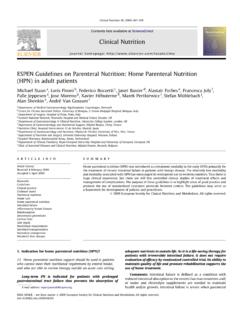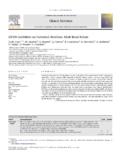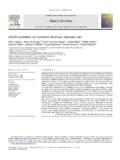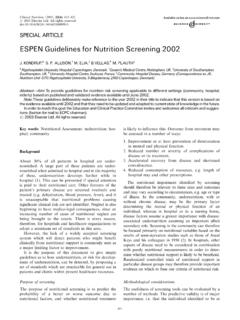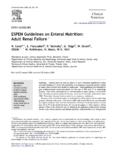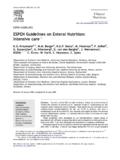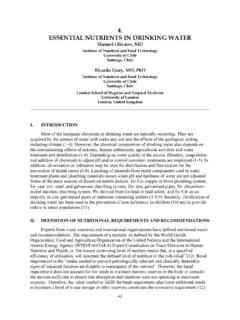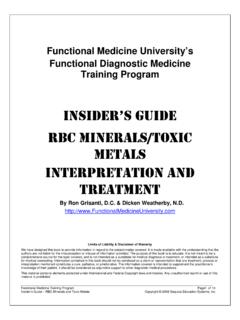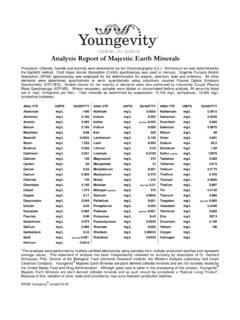Transcription of 7. Iron, Minerals and Trace Elements
1 7. iron , Minerals and Trace ElementsMETHODSL iterature SearchTimeframe: 1990 2004, in addition relevant earlier pub-lications were of publications: randomised controlled studies; case-control or cohort studies; case reports; case series; Words: calcium, chromium, copper, iodine, Iron, manganese, magnesium, molybdenum, newborn, parenteralnutrition, phosphorus, selenium, Trace Elements , : is not routinely provided in parenteral nutritionmixtures and is often not a component of commerciallyavailable Trace element preparations. Currently there areno well-defined recommendations regarding the opti-mum content of iron in parenteral feeds, and intravenousadministration of iron remains problematic.
2 One majorconcern is that of iron overload. Parenteral administra-tion of iron bypasses the homeostatic control of gas-trointestinal iron absorption, causing loss of protectionfrom iron overload if excessive quantities are accumulation of excess iron has been reported inchildren receiving prolonged parenteral nutrition. Ina study of 30 children aged 1 18 years receiving ferroussulphate 100mg/kg per day for an average period of43 months, 12 children showed evidence of plasmaand hepatic iron overload. Ferritin concentrations ng/ml in eight children (.1100 ng/ml in five) andcorrelated with duration of PN. The degree of iron de-position in either hepatocytes or Kupffer cells was mostpronounced in children with the higher ferritin concen-trations ((1) (LOE 2+)).
3 Thus, iron status of childrenreceiving long-term PN should be monitored by regularmeasurement of serum ferritin, and supplementationdecreased if ferritin concentration is raised. AlthoughBen-Hariz et al suggested halving iron intake at ferritinconcentrations of 500 ng/ml and stopping completely at1000 ng/ml, these concentrations probably leave onlya small margin of safety. There is, therefore, an argumentfor curtailing iron supplementation at lower plasmaferritin further concern over parenteral iron administrationis that it may impair immune function and stimulatebacterial growth thus increasing the risk of infection byiron-requiring pathogens (2). iron availability correlateswith bacterial growth and virulence, facilitates viral rep-lication and reverses the bactericidal effect of lactoferrinand lysozyme (3,4).
4 Furthermore, the antibacterial effectof cytokines is mediated by intracellular iron , IL-1, and tumour necrosis factor enhanceferritin synthesis resulting in a shift of cellular iron intoa storage compartment and downregulate transferrinreceptor production decreasing cellular iron uptake and,thereby, iron availability for intracellular pathogens (5). iron therapy has also been implicated in decreasedphagocytosis and inhibition of CD4 and CD8 helperT cell proliferation while enhancing the function of sup-pressor T cells (6). Yet, several components of theimmune response are depressed in iron deficiency. Animpaired capacity for the generation of the oxidativeburst has been observed in phagocytes from iron deficientchildren (7).
5 McFarlane et al studied 40 children withkwashiorkor and low serum transferrin given nutritionalsupport including iron supplements. Many of the childrenwho received iron therapy died shortly after supplementswere begun suggesting that provision of iron in a settingof low transferrin may have resulted in higher circulatingfree iron that could have contributed to the developmentof overwhelming infection and death (8). Septicaemiawith Yersinia enterocolitica has been reported in healthychildren overdosed with oral iron (9). Nevertheless, thereis little clinical evidence that iron supplementation inparenterally fed children increases the risk of sepsis (10).Adverse drug reactions associated with parenteral irontherapy are common, although side effects are mild andself limiting ((11,12) (LOE 2+)).
6 In various series 2 5%of patients experience significant side effects. The pro-cesses leading to iron dextran induced symptoms areunclear, but include a type I (IgE-mediated) anaphylacticreaction which is caused by preformed dextran anti-bodies. Additional mechanisms include a type I anaphy-lactoid reaction that may be caused by transient overloadof the transferrin molecule resulting in small amounts offree iron in the circulation (which appears to be doserelated) and immune complex activation by specific IgGantibody. Symptoms include dyspnoea, wheezing, hypo-tension, nausea, vomiting, abdominal pain, arthralgia andmyalgia. Most side-effects are mild and self-limitingwith severe reactions occurring in a minority of patientsand in conjunction with infusion of larger iron doses.
7 Anincreased incidence of adverse effects has been reportedin patients with collagen diseases. Despite previousJournal of Pediatric Gastroenterology and Nutrition41:S39 S46 November 2005 ESPGHAN. Reprinted with of allergic reactions safe administration of irondextran is possible following a pre-treatment protocolof methylprednisolone, diphenydramine and total dose infusions of iron dextran may be asso-ciated with allergic manifestations the administration ofthe standard maintenance doses (estimated at 1 2 mg/dayup to 10 15 mg/day) may be well tolerated (11,13).There is a paucity of studies on the effects andcomplications of intravenous iron in children. No adverseeffects were reported in 14 children who received15 mg/kg of iron dextran during a two hour period (13),in 2 children who received IV iron at a dose of 250 500 mg at an infusion rate of a 100 mg/min (14), or in5 premature infants given iron dextran at a dose of 10 450mg/kg per day (15).
8 Similarly, no complications wereobserved in a study of 14 very low birth weight infantsreceiving IV iron supplementation at a dose of 200 250mg/kg per day ((16) (LOE 1+)).The ability of iron both as Fe3+(bound form) or Fe2+(free iron ) to generate free oxygen radicals has alsoraised concerns regarding safety. In addition, parenterallipid emulsion also generates peroxides (17). The richcontent of double bonds of the lipid emulsion makes it agood substrate for iron -induced peroxidation. Light in-duced generation of peroxides in PN solutions and theinteraction of iron complexes ( iron dextran) with photonsor substrates of photo-oxidation, such as vitamins orpolysorbate, could explain the unexpected observationthat bound iron is protective against spontaneous per-oxide generation in PN solutions (18).
9 The compatibility of iron with PN solutions has notbeen clearly established. iron dextran cannot be addedto lipid emulsions or all-in-one mixes as it results indestabilisation of the emulsion. Compatibility of irondextran has been shown in amino acid-glucose solutionsfor up to 18 hours (19). Ferrous citrate is also compatiblewith PN solutions, with no observed precipitation duringinfusion periods of 18 24 hours (20).Whether or not there is a need for routine ironsupplementation of PN remains controversial. A specialconcern is the low birth weight infant because of possibleincreased risk of infection observed following intra-muscular iron (21). Arguments in favour of iron sup-plementation in VLBW infants include their low ironstores, rapid growth rate, increased requirements for ironwhen erythropoesis resumes at approximately 2 monthsof age, and caution required in relation to repeated bloodtransfusion.
10 It has been estimated that these newbornsneed 700 to 1000mg/kg per day to reach iron balance(15,16) although considerably lower doses may suffice((22) (LOE 4)); possibly erythropoeitin is needed to usethe iron administered. In term infants receiving PN it isestimated that the daily parenteral iron requirement is100mg/kg per day (22). Although iron reserves should beadequate to supply red cell production for 3 5 months, iron deficiency has been shown to develop much early parenteral iron supplements should becommenced in infants and children receiving PN willdepend on the underlying pathology and degree of bloodloss. In short term PN of a few weeks no adverse effectsresulting from lack of iron supplementation have beenobserved (10).
